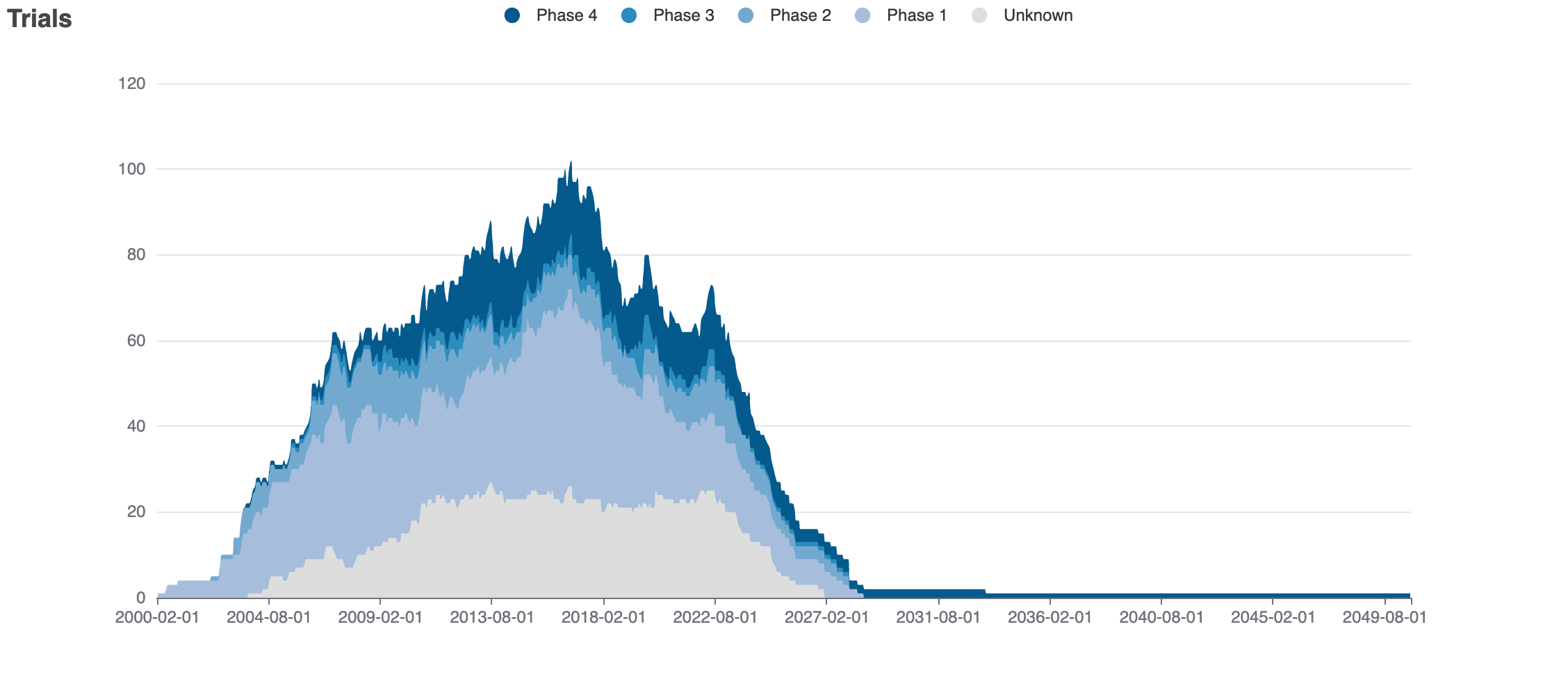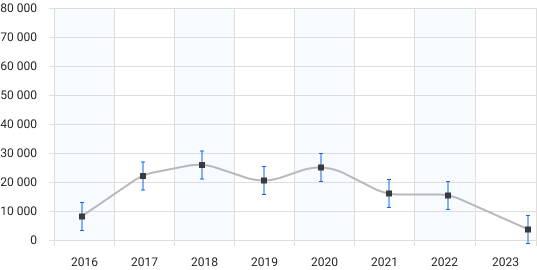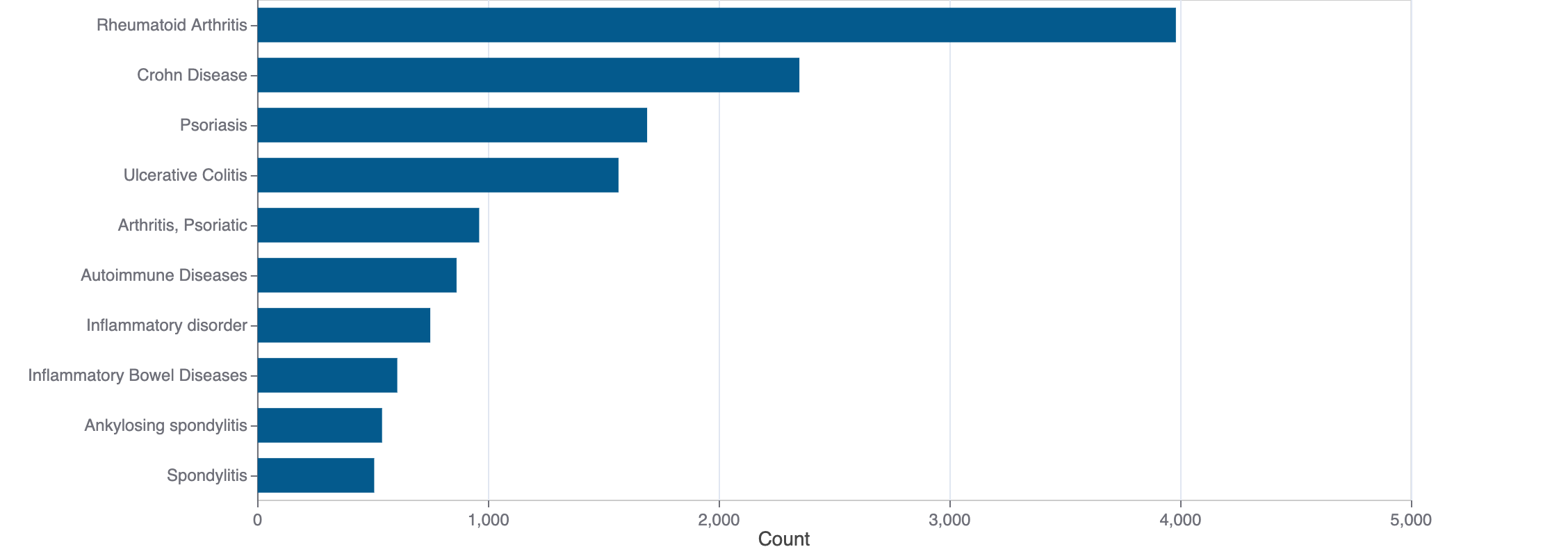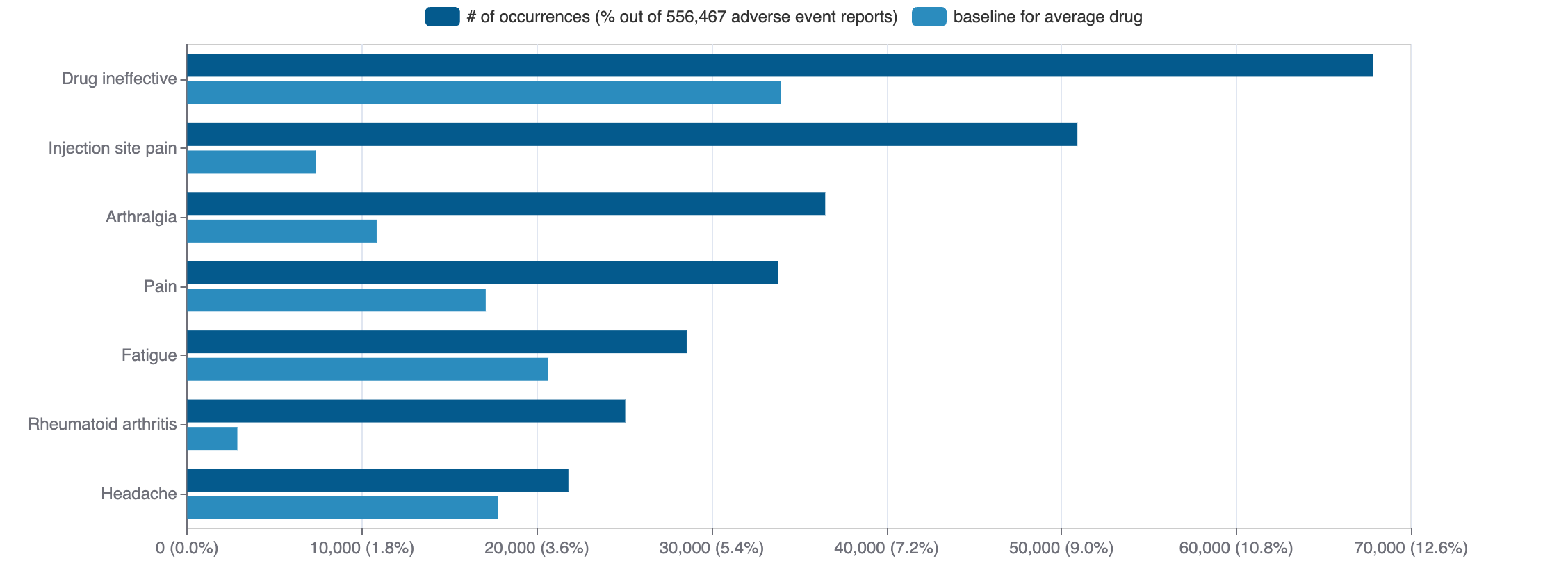Dabigatran
Dabigatran Etexilate, Pradaxa (dabigatran) is a small molecule pharmaceutical. Dabigatran was first approved as Pradaxa on 2008-03-17. It has been approved in Europe to treat replacement arthroplasty and venous thromboembolism. The pharmaceutical is active against prothrombin.
Download report
Favorite
Events Timeline
Commercial
Clinical
Drug
Target
Variants
Financial
Trends
Safety
Events Timeline
5D
1M
3M
6M
YTD
1Y
2Y
5Y
Max
Events
FDA approval date
EMA approval date
Patent expiration date
Study first post date
Last update post date
Start date
Primary completion date
Completion date
Results first post date

Mock data
Subscribe for the real data
Subscribe for the real data
Commercial
Therapeutic Areas
Therapeutic Area | MeSH |
|---|---|
| cardiovascular diseases | D002318 |
| operative surgical procedures | D013514 |
Trade Name
FDA
EMA
No data
Drug Products
FDA
EMA
New Drug Application (NDA)
New Drug Application (NDA)
Abbreviated New Drug Application (ANDA)
Abbreviated New Drug Application (ANDA)
No data
Labels
FDA
EMA
Brand Name | Status | Last Update |
|---|---|---|
| dabigatran | ANDA | 2025-11-17 |
| dabigatran etexilate | ANDA | 2025-12-03 |
| pradaxa | New Drug Application | 2025-06-27 |
Indications
FDA
EMA
No data
Agency Specific
FDA
EMA
Expiration | Code | ||
|---|---|---|---|
DABIGATRAN ETEXILATE MESYLATE, PRADAXA, BOEHRINGER INGELHEIM | |||
| 2024-12-21 | PED | ||
| 2024-06-21 | I-862, NP | ||
HCPCS
No data
Clinical
Clinical Trials
423 clinical trials
View more details

Mock data
Subscribe for the real data
Subscribe for the real data
Indications Phases 4
Indication | MeSH | Ontology | ICD-10 | Ph 1 | Ph 2 | Ph 3 | Ph 4 | Other | Total |
|---|---|---|---|---|---|---|---|---|---|
| Atrial fibrillation | D001281 | EFO_0000275 | I48.0 | — | 4 | 3 | 13 | 27 | 47 |
| Thromboembolism | D013923 | — | — | — | 9 | 11 | 3 | 7 | 30 |
| Venous thromboembolism | D054556 | EFO_0004286 | I74 | — | 8 | 8 | 1 | 5 | 22 |
| Thrombosis | D013927 | — | — | — | 2 | 1 | 2 | 1 | 6 |
| Renal insufficiency | D051437 | — | N19 | 3 | — | — | 2 | — | 5 |
| Replacement arthroplasty | D019643 | — | — | — | — | — | 1 | 3 | 4 |
| Cognitive dysfunction | D060825 | — | G31.84 | 1 | — | — | 2 | — | 3 |
| Heart valve diseases | D006349 | EFO_0009551 | I08 | — | 1 | — | 1 | — | 2 |
| Coronary artery disease | D003324 | — | I25.1 | — | — | — | 1 | 1 | 2 |
| Myocardial ischemia | D017202 | EFO_1001375 | I20-I25 | — | — | — | 1 | 1 | 2 |
Show 9 more
Indications Phases 3
Indication | MeSH | Ontology | ICD-10 | Ph 1 | Ph 2 | Ph 3 | Ph 4 | Other | Total |
|---|---|---|---|---|---|---|---|---|---|
| Hemorrhage | D006470 | MP_0001914 | R58 | 1 | — | 4 | — | 3 | 8 |
| Stroke | D020521 | EFO_0000712 | I63.9 | — | 1 | 2 | — | 2 | 5 |
| Replacement arthroplasty knee | D019645 | — | — | — | 1 | 2 | — | — | 3 |
| Secondary prevention | D055502 | — | — | — | — | 2 | — | — | 2 |
| Neoplasm metastasis | D009362 | EFO_0009708 | — | — | — | 2 | — | — | 2 |
| Replacement arthroplasty hip | D019644 | — | — | — | — | 1 | — | 1 | 2 |
| Hematoma | D006406 | EFO_0010680 | — | — | — | 1 | — | — | 1 |
| Embolic stroke | D000083262 | — | — | — | — | 1 | — | — | 1 |
| Percutaneous coronary intervention | D062645 | — | — | — | — | 1 | — | — | 1 |
| Intracranial sinus thrombosis | D012851 | — | — | — | — | 1 | — | — | 1 |
Indications Phases 2
Indication | MeSH | Ontology | ICD-10 | Ph 1 | Ph 2 | Ph 3 | Ph 4 | Other | Total |
|---|---|---|---|---|---|---|---|---|---|
| Coronary disease | D003327 | — | — | — | 1 | — | — | 1 | 2 |
| Acute coronary syndrome | D054058 | EFO_0005672 | — | — | 1 | — | — | — | 1 |
| Cardiac catheterization | D006328 | — | — | — | 1 | — | — | — | 1 |
| Heart valve prosthesis | D006350 | EFO_0003906 | — | — | 1 | — | — | — | 1 |
| Venous thrombosis | D020246 | — | I82.40 | — | 1 | — | — | — | 1 |
Indications Phases 1
Indication | MeSH | Ontology | ICD-10 | Ph 1 | Ph 2 | Ph 3 | Ph 4 | Other | Total |
|---|---|---|---|---|---|---|---|---|---|
| Healthy volunteers/patients | — | — | — | 53 | — | — | — | — | 53 |
| Liver diseases | D008107 | EFO_0001421 | K70-K77 | 1 | — | — | — | — | 1 |
| Non-alcoholic fatty liver disease | D065626 | EFO_0003095 | K75.81 | 1 | — | — | — | — | 1 |
| Fatty liver | D005234 | EFO_0003934 | — | 1 | — | — | — | — | 1 |
| Alzheimer disease | D000544 | EFO_0000249 | F03 | 1 | — | — | — | — | 1 |
| Liver failure | D017093 | — | K72.9 | 1 | — | — | — | — | 1 |
| Hepatic insufficiency | D048550 | — | — | 1 | — | — | — | — | 1 |
| Chronic renal insufficiency | D051436 | — | N18 | 1 | — | — | — | — | 1 |
| Chronic kidney failure | D007676 | EFO_0003884 | N18.6 | 1 | — | — | — | — | 1 |
| Cardiovascular diseases | D002318 | EFO_0000319 | I98 | 1 | — | — | — | — | 1 |
Indications Without Phase
Indication | MeSH | Ontology | ICD-10 | Ph 1 | Ph 2 | Ph 3 | Ph 4 | Other | Total |
|---|---|---|---|---|---|---|---|---|---|
| Blood coagulation tests | D001780 | — | — | — | — | — | — | 1 | 1 |
| Drug-related side effects and adverse reactions | D064420 | — | T88.7 | — | — | — | — | 1 | 1 |
| Blood coagulation disorders | D001778 | EFO_0009314 | D68.9 | — | — | — | — | 1 | 1 |
| Hemostatic disorders | D020141 | — | — | — | — | — | — | 1 | 1 |
| Hemorrhagic disorders | D006474 | — | D69.9 | — | — | — | — | 1 | 1 |
| Medication adherence | D055118 | EFO_0006344 | — | — | — | — | — | 1 | 1 |
| Recreational drug use | D000084783 | — | — | — | — | — | — | 1 | 1 |
| Drug tolerance | D004361 | — | — | — | — | — | — | 1 | 1 |
| Transient ischemic attack | D002546 | EFO_0003764 | G45.9 | — | — | — | — | 1 | 1 |
Epidemiology
Epidemiological information for investigational and approved indications
View more details
Drug
General
| Drug common name | Dabigatran |
| INN | dabigatran |
| Description | Dabigatran is an aromatic amide obtained by formal condensation of the carboxy group of 2-{[(4-carbamimidoylphenyl)amino]methyl}-1-methyl-1H-benzimidazole-5-carboxylic acid with the secondary amoino group of N-pyridin-2-yl-beta-alanine. The active metabolite of the prodrug dabigatran etexilate, it acts as an anticoagulant which is used for the prevention of stroke and systemic embolism. It has a role as an anticoagulant, an EC 3.4.21.5 (thrombin) inhibitor and an EC 1.10.99.2 [ribosyldihydronicotinamide dehydrogenase (quinone)] inhibitor. It is an aromatic amide, a member of benzimidazoles, a carboxamidine, a member of pyridines and a beta-alanine derivative. |
| Classification | Small molecule |
| Drug class | thrombin inhibitors (argatroban type) |
| Image (chem structure or protein) |  |
| Structure (InChI/SMILES or Protein Sequence) | Cn1c(CNc2ccc(C(=N)N)cc2)nc2cc(C(=O)N(CCC(=O)O)c3ccccn3)ccc21 |
Identifiers
| PDB | — |
| CAS-ID | 211914-51-1 |
| RxCUI | — |
| ChEMBL ID | CHEMBL48361 |
| ChEBI ID | 70752 |
| PubChem CID | 216210 |
| DrugBank | DB14726 |
| UNII ID | I0VM4M70GC (ChemIDplus, GSRS) |
Target
Variants
No data
Financial
Revenue by drug
$
€
£
₣
No data
Estimated US medical usage
Dabigatran
Total medical expenditures per year (USD, in millions)

Mock data
Subscribe for the real data
Subscribe for the real data
Number of persons purchased

Mock data
Subscribe for the real data
Subscribe for the real data
Number of purchases

Mock data
Subscribe for the real data
Subscribe for the real data
Refill frequency

Mock data
Subscribe for the real data
Subscribe for the real data
Price per prescription (USD)

Mock data
Subscribe for the real data
Subscribe for the real data
Tabular view
Trends
PubMed Central
Top Terms for Disease or Syndrome:

Mock data
Subscribe for the real data
Subscribe for the real data
Additional graphs summarizing 16,977 documents
View more details
Safety
Black-box Warning
Black-box warning for: Dabigatran, Dabigatran etexilate, Pradaxa
Adverse Events
Top Adverse Reactions

Mock data
Subscribe for the real data
Subscribe for the real data
77,693 adverse events reported
View more details
© 2020-2025 Collaborative Drug Discovery Inc. (CDD) | Terms of Use